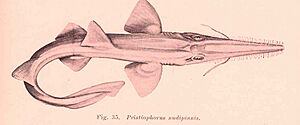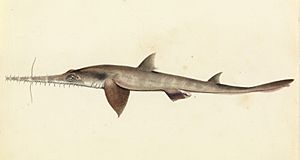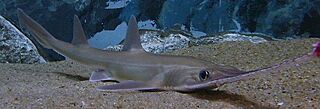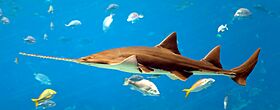Sawshark facts for kids
Quick facts for kids Sawsharks |
|
|---|---|
 |
|
| Shortnose sawshark, Pristiophorus nudipinnis | |
| Scientific classification |
|
| Kingdom: | Animalia |
| Phylum: | Chordata |
| Class: | Chondrichthyes |
| Infraclass: | Euselachii |
| Superorder: | Selachimorpha |
| Order: | Pristiophoriformes L. S. Berg, 1958 |
| Family: | Pristiophoridae Bleeker, 1859 |
| Type species | |
| Pristiophorus cirratus Latham, 1794
|
|
| Genera | |
|
|
A sawshark is a fascinating type of shark known for its long, flat snout that looks just like a saw! This special snout is covered with sharp teeth along its edges. Sawsharks use this unique "saw" to find and catch their food in the ocean. They belong to a group of sharks called Pristiophoriformes.
There are several kinds of sawsharks, like the longnose sawshark, the shortnose sawshark, and the sixgill sawshark. You can find these amazing creatures in many parts of the world, especially in the Indian Ocean and the southern Pacific Ocean. They usually live in deep waters, often between 40 and 100 meters down, but some, like the Bahamas sawshark, have been found much deeper, even up to 915 meters!
Contents
What Do Sawsharks Look Like?
Sawsharks have two long, whisker-like feelers called barbels on their snouts. They also have two dorsal fins (the fins on their back), but they don't have anal fins (fins near their tail). Most sawsharks have five gill slits on each side of their head, but one type, the Pliotrema genus, has six! The teeth on their saw-like snout are usually a mix of large and small ones.
These sharks can grow up to about 1.5 meters (5 feet) long and weigh around 8.5 kilograms (18.7 pounds). Female sawsharks are often a little bigger than males. Their bodies are covered in tiny, tooth-like scales called placoid scales, which are very tough. Many sawsharks are yellowish-brown, sometimes with dark spots. This color helps them hide on the sandy ocean floor.
How Do Sawsharks Find Food?
Sawsharks mostly eat small fish, squid, and crustaceans like crabs. Scientists are still learning exactly how sawsharks use their unique saw-like snout and barbels. It's thought that they might swing their saw from side to side to stun or injure their prey, just like sawfish do. Their saw can also be used to defend themselves from other predators.
The saw is covered with special sensors called ampullae of Lorenzini. These sensors can detect the tiny electric fields that living creatures give off. This helps the sawshark find prey that might be hiding under the sand!
Sawshark Life Cycle and Reproduction
We are still learning a lot about the life of sawsharks. They reproduce by being ovoviviparous, which means the eggs hatch inside the mother's body. The mother then gives birth to live young. They usually have litters of 3 to 22 pups every two years. After about 12 months of pregnancy, the baby sawsharks are born, already about 30 centimeters long. To keep the mother safe, the pups' saw teeth are angled backward while they are still inside her. Sawsharks are believed to live for 10 years or more.
Sawsharks and People
Because sawsharks live in deep parts of the ocean, they don't often come into contact with humans. Most sawshark species are not considered endangered. This means their populations are stable, or we don't have enough information to know for sure. It's good news that these unique sharks are generally doing well in their ocean homes!
Types of Sawsharks
There are currently ten known species of sawsharks. They are divided into two main groups, or genera:
- Pliotrema
- Pliotrema annae (Anna's sixgill sawshark)
- Pliotrema kajae (Kaja's sixgill sawshark)
- Pliotrema warreni (Warren's sixgill sawshark)
- Pristiophorus
- Pristiophorus cirratus (Longnose sawshark or common sawshark)
- Pristiophorus delicatus (Tropical sawshark)
- Pristiophorus japonicus (Japanese sawshark)
- Pristiophorus lanae (Lana's sawshark or Philippine Sawshark)
- Pristiophorus nancyae (African dwarf sawshark)
- Pristiophorus nudipinnis (Shortnose or southern sawshark)
- Pristiophorus schroederi (Bahamas sawshark)
Sixgill Sawshark
The sixgill sawshark (Pliotrema warreni) is special because it has six pairs of gills, unlike most sharks that have five. These sharks are pale brown with a white belly. Females can grow up to 136 cm, and males up to 112 cm. They eat shrimp, squid, and other fish. You can find them near southern South Africa and Madagascar, living in waters from 37 to 500 meters deep. They give birth to 5 to 7 pups at a time.
Longnose Sawshark
The longnose sawshark (Pristiophorus cirratus) is known for its very long, thin, and flat snout. It has barbels halfway down its snout and special sensors called ampullae of Lorenzini. This sawshark is not very big, growing from about 35 cm at birth to 96-112 cm as adults. They can weigh up to 8.5 kg. They live off the southern coast of Australia and in the eastern Indian Ocean, from the surface down to 600 meters. They use their barbels to find small crustaceans on the ocean floor, then stun them with their snout.
Shortnose Sawshark
The shortnose sawshark (Pristiophorus nudipinnis) lives in southeastern Australian waters. It looks similar to the longnose sawshark but has a wider saw and a more even brown color. Its barbels are closer to its mouth than those of the longnose sawshark. Shortnose sawsharks likely feed mainly on fish. They are generally slate grey with no markings and have a pale white belly. Females can reach about 124 cm long, and males about 110 cm. They can live up to 9 years. Like other sawsharks, they live on the ocean floor and use their barbels and saw to find and paralyze prey. They give birth to 7 to 14 pups every two years.
Japanese Sawshark
The Japanese sawshark (Pristiophorus japonicus) lives off the coasts of Japan, Korea, and Northern China, swimming at depths of up to 500 meters. It has many large teeth on its saw, both in front of and behind its barbels. Like all sawsharks, it gives birth to live young and eats crustaceans and other creatures that live on the ocean bottom.
Lana's Sawshark
Lana's sawshark (Pristiophorus lanae) was discovered in 1966 near the Philippine coast. It has a dark brown back and a pale white belly. This slender shark has five gills on each side and can grow to about 70 cm long. It was named after Lana Ebert.
African Dwarf Sawshark
The African dwarf sawshark (Pristiophorus nancyae) is a small, five-gill sawshark found off the coast of Mozambique. It was first discovered in 2011 at a depth of about 488 meters (1,600 feet). It has also been seen near Kenya and Yemen. You can tell it apart by its location and by its barbels being closer to its mouth than the tip of its saw. It has a brownish-grey color with a white belly.
Bahamas Sawshark
The Bahamas sawshark (Pristiophorus schroederi) lives in deep waters (400–1000 meters) near Cuba, Florida, and the Bahamas. Not much is known about this deep-sea dweller, but studies are ongoing. They are about 80 cm long and have the distinctive saw-like snout with teeth.
Sawsharks vs. Sawfish: What's the Difference?
Sawsharks and sawfish both have long, saw-like snouts, and they are the only two types of fish with this special feature! However, they are actually quite different. Sawfish are not sharks; they are a type of ray.
Here are the main differences:
- Gills: Sawsharks have their gill slits on the sides of their head, just like other sharks. Sawfish, being rays, have their gill slits on their underside.
- Barbels: Sawsharks have a pair of long barbels (whiskers) on their saw. Sawfish do not have these barbels. Sawsharks use their barbels like antennae to feel for prey on the ocean floor.
- Saw Teeth: The teeth on a sawshark's saw are usually a mix of large and small ones. Sawfish have teeth that are all about the same size.
- Size: Sawsharks are relatively small, growing up to about 1.5 meters (5 feet). Sawfish can grow much larger, sometimes up to 7 meters (23 feet)!
- Habitat: Sawsharks prefer deep ocean waters, while sawfish usually live in shallow coastal waters.
Both sawsharks and sawfish use special sensors on their saws, called ampullae of Lorenzini, to detect the electric fields of hidden prey. This helps them find food even when it's buried in the sand.
| Comparison of Sawsharks and Sawfish | ||
|---|---|---|
|
|
||
| Characteristic | Sawshark | Sawfish |
| Gill openings | Peripheral (sides) | Ventral (underside) |
| Barbels | Single pair of barbels on saw | No barbels |
| Saw teeth | Alternate between large and small | Equal size |
| Habitat | Deep offshore waters | Shallow coastal waters |
| Size | Relatively small, reaching only 5 ft | Relatively large, reaching 23 ft |
See also





